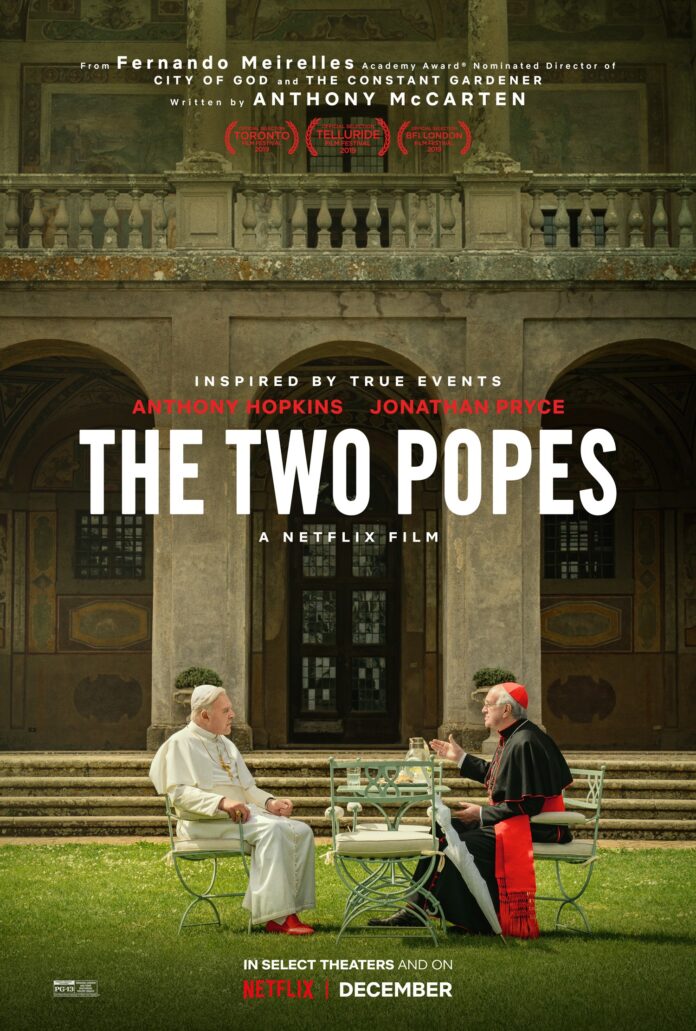An early glimpse of The Two Popes shows the cardinals Jorge Bergoglio and Benedict Ratzinger in a washroom; flowing the demise of Pope John Paul II, all the cardinals have gathered in Vatican City to elect his successor.
Bergoglio is seen washing his hands when Benedict asks him of the tune he’s whistling. Bergoglio says, “What hymn is that?” “Oh, it’s ‘Dancing Queen’,” Bergoglio replies. “‘Dancing Queen?’” Benedict asks, at a loss. “Yes, by ABBA,” Bergoglio says. “ABBA?”
Benedict, who is a stranger to pop quartet, wonders what that means.
This interaction is a sign of a clear difference between the two men, both destined to be popes.
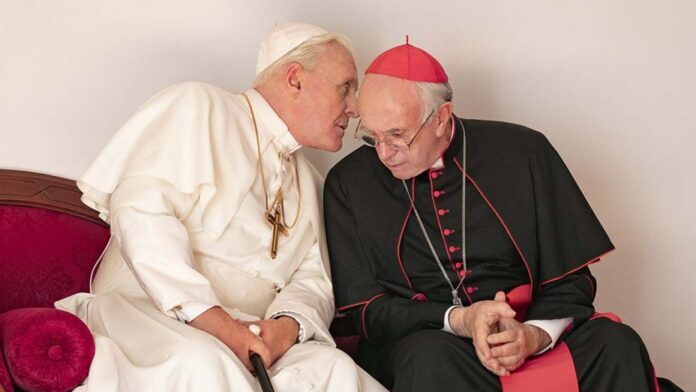
Their differences become even more apparent by the following scene: featuring red-robed cardinals walking down the stately white marble halls of the Vatican, shot with symmetrical precision.
Benedict represents the old guard of dogma and determined to stand a watch on his believes that the Catholic Church must remain unchanging in a changing-beyond-all-recognition world.
On the other hand, Bergoglio represents reform, a spiritual leader of and among the people.
And yet, the following flow of the film showcases that even for all their differences in personality, ideology, and outlook, their love for and submission to God is what binds Benedict and Bergoglio.
The bulk of The Two Popes’ narrative is spread over two days, with the events that preceded and followed those two days (namely, the ascension of first Ratzinger and then Bergoglio as Pope Benedict XVI in 2005 and Pope Francis in 2013, respectively) acting as bookends.
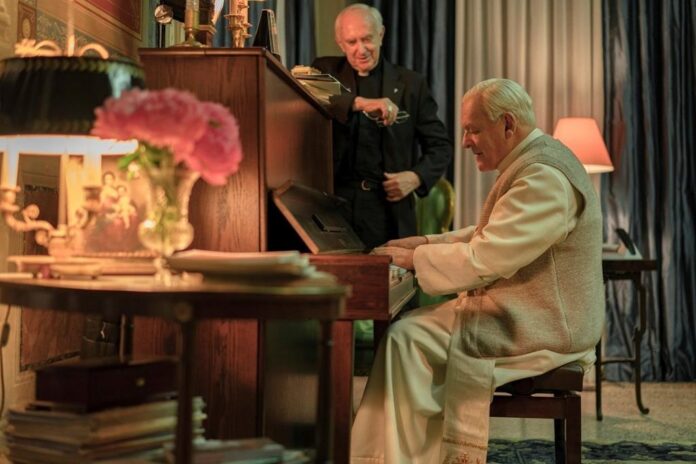
The two-day event in question arises Bergoglio, decides to turn in his resignation years after the election of Benedict as Pope. Bergoglio and Pope meet in Rome and goes to his summer residence where Benedict entirely avoids accepting or discussing Bergoglio’s resignation.
They walk through the garden having discussions about Bergoglio’s position on various issues (same-sex marriage, celibacy for the clergy, punitive measures against priests found guilty of sexual abuse). Pope Benedict disagrees with all these matters, incidentally.
They began to find common ground over the course of the evening, each sharing the ways of their communication with God and of receiving their calling.
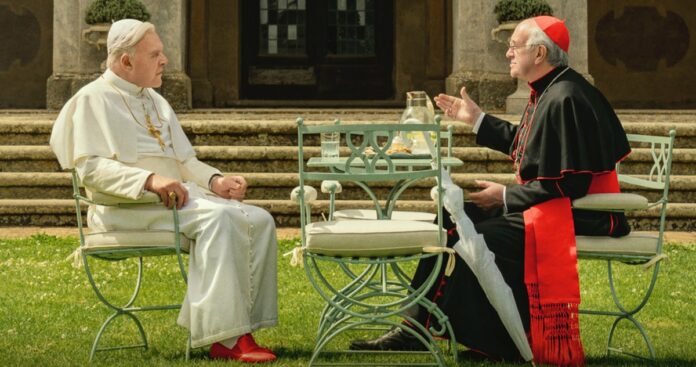
This meeting spans over the time when the Church is mired in controversy. The “Vati-Leaks” scandal’s fall-out intrudes on their time together, as Benedict is urgently called to the Vatican City.
Benedict and Bergoglio’s conversations continue there, with each sharing deeply shameful chapters from their past, before Benedict tells him why he won’t accept his resignation: he wants to step down as Pope and have Bergoglio succeed him.
A ray of genuine affection and unlikely friendship has sprung between the two men before they part. Bergoglio’s charm has called for the affection and friendship; along with Benedict feeling something in younger man which he had not felt recently: a closeness with God.
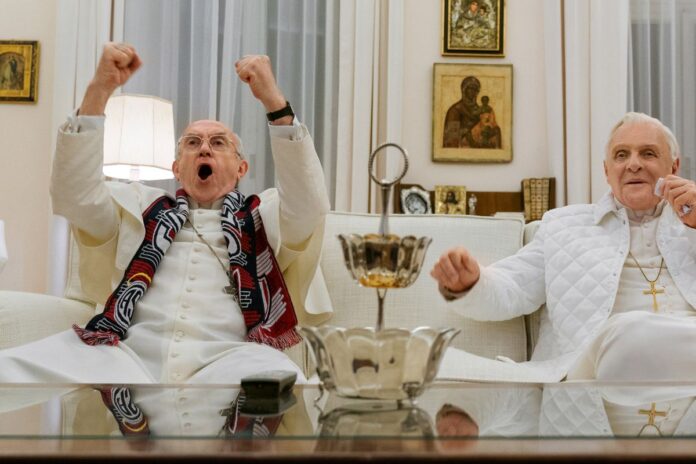
Did anyone expect Anthony Hopkins and Jonathan Pryce to be anything less than spellbinding in their roles?
Hopkins plays Benedict with utmost sincerity and by combining physical frailness with a steely resolve; the characteristics the act calls for.
Pryce’s Bergoglio is the perfect foil to Hopkins’ Benedict, a man of the people, at ease with himself and able to make friends wherever he goes. Each so different, each so compelling as they spar, then bond.
Aside from the great performances, The Two Pope is an unadulterated pleasure to watch.
Every moment is framed with utmost care: sunlight falling into a room just so, the geometry of how characters are positioned within a space.
The Vatican sequences are so gorgeous that would please even the most exacting of aesthetes: the electing of the Pope brings together color, sound, and movement like a choreographed routine.
Writer Anthony McCarten (The Theory of Everything, Darkest Hour, Bohemian Rhapsody) and director Fernando Meirelles (City of God) turn the former’s play into a piece of cinematic art, while also imbuing it with deep reserves of humor, emotion, and warmth.
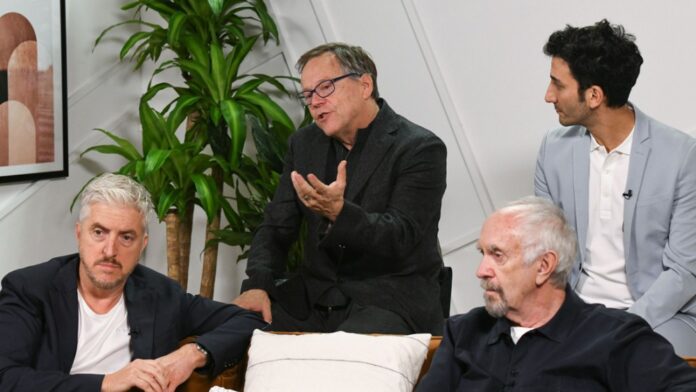
The Two Popes dis does not pull a curtain over the Church’s failures or its gross role in perpetuating child sexual abuse.
By placing their imagined conversations and contrasting personalities together, The Two Popes shows a Catholic Church at the crossroads.
This story calls to 1.2 billion people around the globe.
The film’s release comes just months after the former pontiff expressed his views on the problem of sexual abuse among the clergy in a letter.
This seemed like a challenge to Pope Francis’ position, and the differences in their respective ideologies haven’t exactly faded away.
The Two Popes, however, chooses to end on a hopeful note; a quiet, charming film that’s a reaffirmation of faith.

